Home › Forums › Explore Subjects › Figure, The › 2 copy study
- This topic has 14 replies, 4 voices, and was last updated 4 years, 5 months ago by
 KreativeK Moderator.
KreativeK Moderator.
-
AuthorPosts
-
October 31, 2019 at 4:27 pm #479755
I did this yesterday. Reference:
https://i.pinimg.com/originals/be/4c/85/be4c85307712f1ac58c9ed3e02bdec08.jpg
*
charcoal conte paris 2b photocopy paper a3

*While I started this a couple of days ago, http://s3.amazonaws.com/wetcanvas-hdc/Community/images/24-Nov-2008/154293-2008-11-24_205406.jpg
Looking through featured pages on this forum I found one of the many incredible posts (, post. Discussion dedicated to the MUcha studies (beautiful what I saw of MUcha and also beautiful the studies), I am ignorant about the Art Nouveau (and in general) but now I want to look for some information (read better links) and see other works by other artists to learn about Art Nouveau at least a little (also because I’m enjoying it).
*I started drawing to do it in pencil on a c4 cansono sheet (it is a4, a little bigger than a4, smooth about 200g I think) (I tried to change the positioning of the album (usually I am in front of the PC if I refer to it) I see on the PC, in this case I used monitor as reference), changed trying to align the monitor as much as I could with the sheet
but I don’t have the space to do it, to try again this well, I also believe that it didn’t make sense, thinking about it, it probably makes sense to print the sheet and put it next to it (I used to print some time ago but the values weren’t good, so we didn’t understand then I had returned to the PC (therefore making measurements or comparisons (trying to remember to learn this), or at sight, so at random …)
but I believe that I could possibly only switch to shading the monitor)
doubt and if instead I put the reference on my side as if I were drawing live (even if I don’t know the correct positions for those who draw for the sheet and for reference).
*I speak of this because two years ago I had seen something but I could not understand how to position the sheet in that way,
long ago I saw a video trailer where the artist was perhaps about a meter from the photo, he drew his face in a glass or plexigas and then superimposed it on the face of the reference that matched,.
this was then also with the model I think, but I don’t know how the picture was put, and anyway I wouldn’t remember it, so not like, if it’s side by side but sideways, I think (I don’t know if it can be done even closer ).
I did not understand position and distance, if it can be closer.
*I don’t know If this is a better way to train an eye too (if it is something that is actually taught, that can be learned or improved),
I don’t say to make a portrait but like the skeleton of a bottle, cube.
This method is nice that you could do then both by drawing an object and a photo. So exercise both things
Maybe if photos are small it’s difficult but if you can vary distance.
I don’t know whether to try this thing or in the end it is enough to put side by side photos (I don’t know if it makes sense what I’m writing, sorry)

instead of croqui caffe I used only one photo, to practice with loomis,
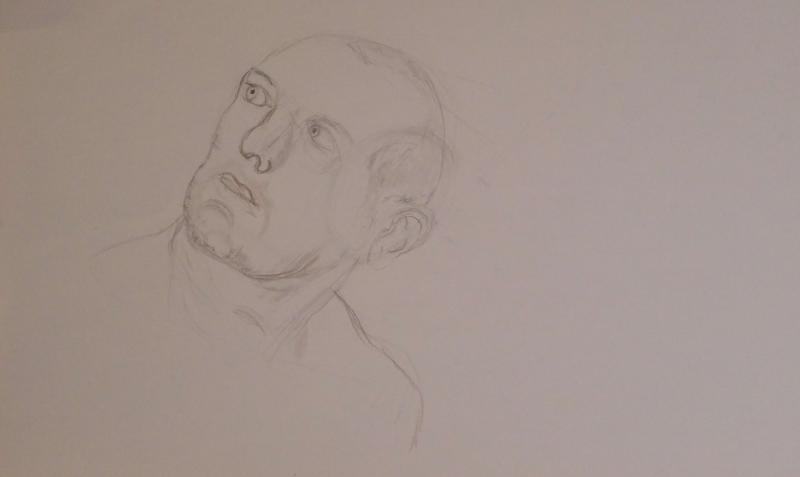
thanks for seeing

- C & C welcome ( comments and criticisms highly appreciated)
— NOT allowed for Al training
October 31, 2019 at 9:24 pm #901167today I did this, (also in a similar theme, head, procedure lo) but unlike the previous one it is from design.
before I started drawing he was a boy, at the end he was a man

seeing the photo it seems to me this,
a bit like some noses, the previous drawings,
in fact I did this even when I was drawing as a child,
a female face (when I used to draw them, I usually tried to draw comics) became a bearded man …
I believe that it is right then that I am now trying above all with women models, so practicing I can improve this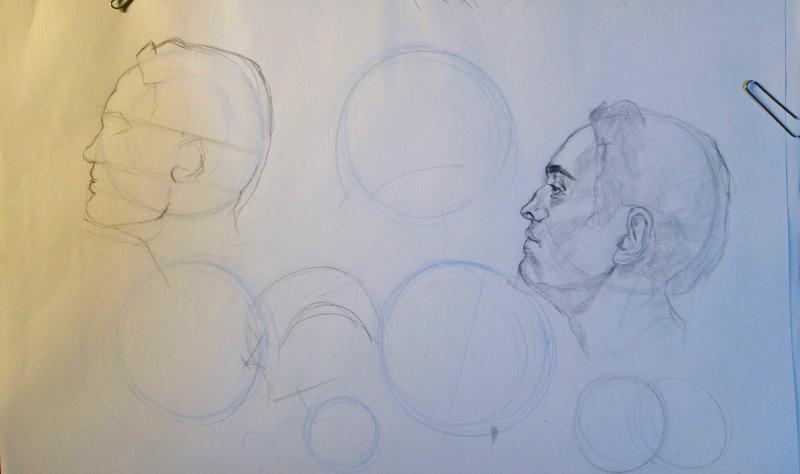
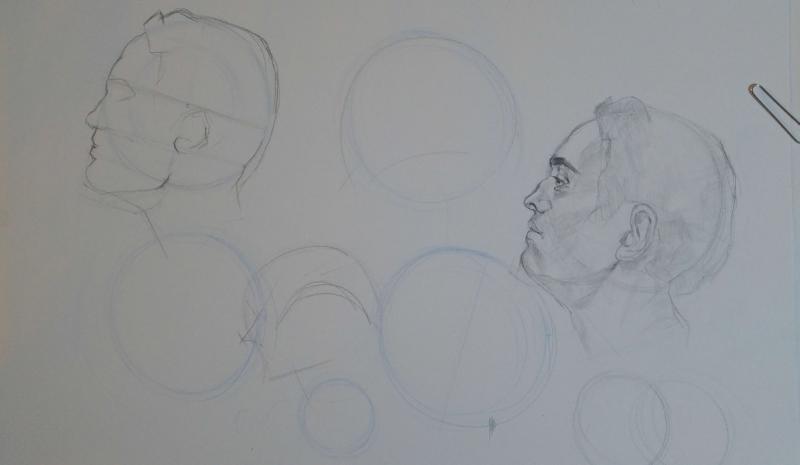
thanks for seeing
- C & C welcome ( comments and criticisms highly appreciated)
— NOT allowed for Al training
November 1, 2019 at 12:09 pm #901164coming along nicely. You can afford to be a bit bolder with the tone you use, darker darks, lighter highlights. The proportions look pretty good though the bald gent needs a bit more forehead, there is more head above the eyes than you’ve shown.
Keep going!C&C always welcome.
Instagram harry.hamillNovember 1, 2019 at 8:40 pm #901161You are doing well with these studies Joe and drawing better. I think you are getting the idea.
It’s important that the subject I am looking at and the drawing are in the same visual field. Above the paper or to the left.
If I am drawing from a photo on my computer monitor I put my drawing board on my lap and lean it against the desk the computer screen sits on and work like that so the photo is above my board.
I’m right handed so I normally look at the subject placed at my left unless I am working from the computer screen. I never look to the right across my drawing arm to capture something, it’s always on my left or in front if I’m sitting. I also have a small table easel which I stand in front of and a larger easel if I am wanting a bigger painting. I hope this gives you some answers.
You can use any size paper you want I suggested A4 and A3 because you need to get a feel for the spatial relationships and if the paper is too small or the drawing is small you don’t develop the kinesthetic sense, spatial relationships are too small to get a feel for where to place things. You can go from big to small it’s much harder if you draw small all the time to go bigger you need to get a feel for scale. Some people prefer to work small and others to work big find what suits you. If you look at Michelangelo’s drawing on page 206 of Drawing Lessons from the Great Masters, you will see it is a little bit smaller than A4. Not all figure drawings are large.
Years ago in life drawing I used A2 and I think Mac draws A2. Nowadays I use A3, A4 and A5. A5 is good for sketching outside in the street or cafes, buses, trains etc as it’s not so noticeable and therefore you can get sneaky sketches of people.
Bill,
https://www.flickr.com/photos/artistoz/
Instagram, billwperryNovember 2, 2019 at 10:37 am #901168Harry thank you for the kind words and the help, the suggestions.
* On the face of man, yes, now that you point it out to me, I’m noticing that I’ve stretched that part a little
With the copy of Mucha then I will go ahead with the shading (a little I took it for shadin, finished the posting)
Yes, Shading and lights is something I have to learn and understand better (even applying values, more values, etc.). To practice more, this year I am trying to pay more attention to the darkness.

Good weekend- C & C welcome ( comments and criticisms highly appreciated)
— NOT allowed for Al training
November 2, 2019 at 10:52 am #901169ArtistOz thank you for your appreciation, encouragement and help.
Yes, the clarifications on the station, they clarified a lot, even on the provision of the reference for right-handed people, I use right-handed and I also had this doubt, (in time I was looking for something about this, I had seen left-handed people with a model on the right, in one case, however, there was an artist with a right hand who had a model on his right), thank you very much.
On the sheets, understood, it’s something I didn’t know that is very useful, I wanted to draw in a more correct format,
initially I drew rather small, I used little space even in the a4 sheet (maybe type a6), but starting to notice this, to try with larger sheets, a4 and take the first a3, actually it is not automatic in the passage but impression and that it was right (maybe in the small sheet I omitted parts,, a detail, make an eye, or I had the doubt, taking the coal that perhaps this required to be managed and perhaps even more space,), in the last year I was trying to pay attention to the sheets used while admiring a drawing.
moreover the formats that I would like to use are a4, a5 and a3 (a2 no because I would not have space, the place to use it correctly) so I find it nice to get used to something that also allows you to switch to these various formats having already a habit of using them. And it’s nice to understand why, thanks from the heart.
I’m seeing the drawing by Michelangelo, figures of male nude, it’s about 25, x 15, cm
Over time I had also taken 2 Sketchbooks and I am a5, thanks also for straight.
I remembered a book I wanted to ask you about, I think I forgot to mention this book, about a year ago or + I had seen this book by Lutz online. For a few days I had copied, tried a few pages,
Drawing Made Easy with selections from Practical Drawing
If it is a bit like a bargue, however, aimed at children or beginners, if you take it back, complete it
I wanted to ask you this or if the author in general is one of those you would recommend.
I thought there was an anatomy one, I searched now, this is https://library.si.edu/digital-library/book/practicalartanat00lutz but I asked you if I was writing to you and if Drawing Made Easy with selections from Practical Drawing (sorry that I always take advantage of asking) do you think it could be useful to use it, in case I would do it again from the beginning, maybe a little every day if you think it is useful
thanks, good weekend
- C & C welcome ( comments and criticisms highly appreciated)
— NOT allowed for Al training
November 3, 2019 at 8:52 am #901170so I came, I put 2 photos that I was undecided on a couple
looking at them now, the most obvious errors that will occur are what I seem to notice is the angle of the profile, the lost inclination
reference http://s3.amazonaws.com/wetcanvas-hdc/Community/images/24-Nov-2008/154293-2008-11-24_205406.jpg
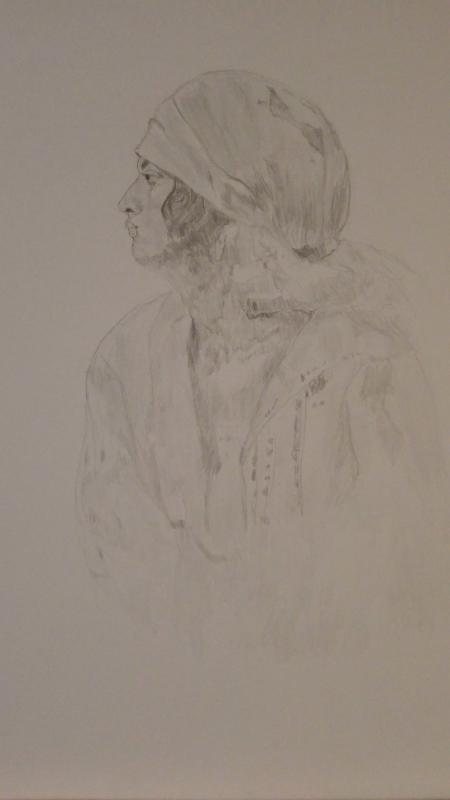
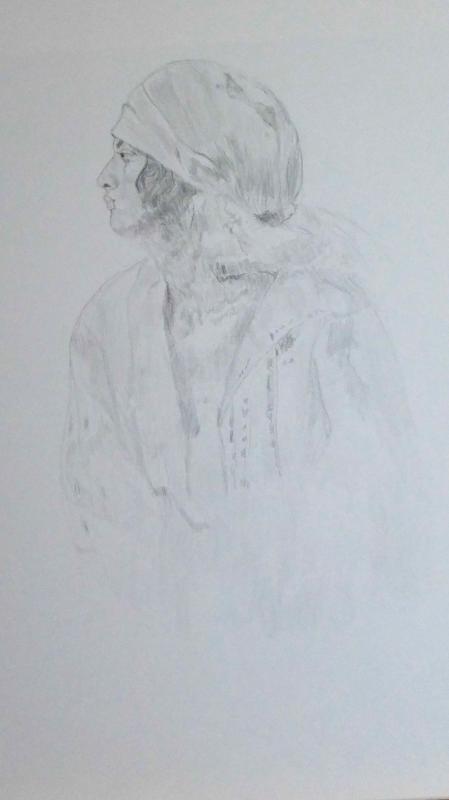
I also did this from loomis,
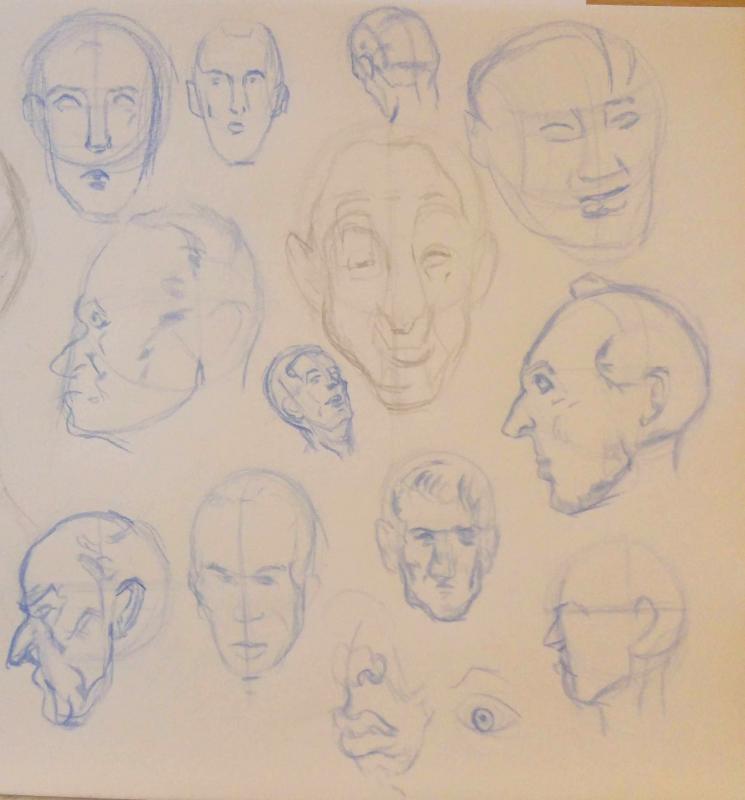
and then this is always designed by CUong as the last head.
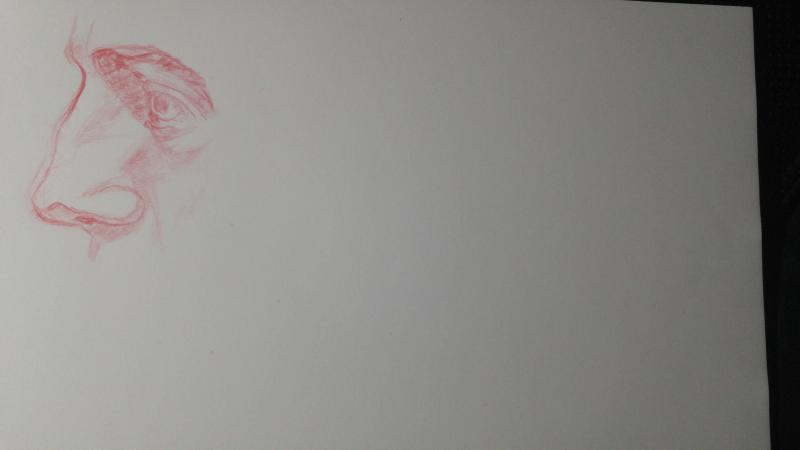
thanks for see
have a nice Sunday- C & C welcome ( comments and criticisms highly appreciated)
— NOT allowed for Al training
November 4, 2019 at 2:20 am #901162Hi Joe, the problem with Lutz’s book on anatomy is it has too many words and not enough illustrations. If you have Bridgman’s book Constructive Anatomy you can compare his drawings with Lutz’s after page 200 I think you will see Bridgman is superior. Drawing made Easy is a typical book for beginners, for illustrators, cartooning and even animation. It’s not a bad book and has the same approach of the academic method of Schema to outline to tone. Where it is useful is in inventing images by working from the simple constructions shown in the book.
In Charles Bargue’s drawing course he works from Schema to outline to tone this is the basic academic approach, similar to Lutz’s. Drawing Made Easy. Bargue then teaches a tonal observation approach once the outline is achieved. It can take 5 hours or more to get an outline of the figure correct. Lutz uses a tool similar to the envelope used by Tony Ryder which he learnt from Ted Jacobs. Its a composition tool that helps you map out a figure/animal or object. Map out the boundaries then refine it. Frank Reilly fans do the same with rhythms instead of shape. Line of action, line 1 and line 2 of the limbs then come back with character lines to give shape. All these approaches are two or more steps in drawing.
I prefer direct observation drawing, one step, I’m not a big fan of construction, however in saying that it is very useful for some to help them visually understand. It’s important you know my bias. These days I teach a simple approach to drawing based on observation and line. If you follow the list I wrote on another thread of yours you have all the ingredients for your own self teaching. I noticed you mentioned that you missed the direction the lady was looking in your drawing. The lost inclination you said. This is part of your training being aware of directions it’s good you see it now.
When you have to invent the subject this is a time problem with learning the figure and other things rather than work from observation, the easiest way is to teach these construction step methods. But if you know how perspective works, understand shapes and how light affects them you can invent your own creatures etc from observation, it just takes longer to acquire the skill. I have friends 40 years ago inventing their own fantasy worlds based on known observation without construction. It’s important to do sketches from life if you can. Even stolen ones in a cafe. It’s not important you draw well it’s important you can see and improve your observation skills. Of course keep doing what you are doing, everything helps at your stage and follow the books after a while when you know more you can be more discerning on what books you want to follow.
I have Gottfried Bammes’ book Anatomy for artists, the 500 page one translated into English. I feel it is too much information but it is supposed to be the best book on anatomy for artists. I’m not a fan of mechanical representations of the body. It does help to know the underlying forms of the body but a lot of muscles just blend in together you often don’t see the individual muscles. Unless you are teaching anatomy or discussing it the names of muscles and bones are less important than the shapes.
Loomis’s Creative Illustration is a good book, Bammes liked Burne Hogarth’s book Dynamic Anatomy but felt he over did it on muscles too unnatural and no skeleton information. Bammes didn’t think much of English speaking books on anatomy. He thought Loomis was facile and slick but not everyone needs to be as rigorous as Bammes in knowing anatomy. Loomis was an illustrator and at the time the only art author worth studying for wanna be illustrators in a time where modern art rubbished the figure.
Bill,
https://www.flickr.com/photos/artistoz/
Instagram, billwperryNovember 4, 2019 at 6:33 pm #901171hi ArtistOz I sincerely thank you for the answer and for further clarifications.
You’re right about Lutz Anatomy,
I’m sorry, I was quoting it thinking it was for anatomy (or that he had made other other books for it) but similar in part to Drawing made Easy even though I had leafed through it very little was mostly text.
Seen better, true.
In addition, Yes, I did book Bridgman, I had taken Constructive Anatomy and Heads, Features and Faces together in January, you’re right, I’m flipping through it now and it’s better, as well as looking more searchable even by structure (more images, it seems less dispersive noticing what says over text in lutz).
Thank you very much for explanations on bargue, su tone,. on envelope, on really.
looking for head construction to try to learn portraits, trying to loomis, I had seen that there was also Really ,, abstraction,
I had thought of trying with loomis and that I would have confused them anyway.then I saw jeff watts’ youtube channel and he reported that Join Watts Atelier.
on my mind I was seeing this trying to understand the facial plans. on the forum or by looking at asaro I had discovered about this artistanother video on this this https://www.youtube.com/watch?v=PQ5ZaK1XExE
I tried to get an idea, to understand what those lines were on the faces
but for the figure I had seen drawings, I believe in wetcavans, looking for posts on the various methods of drawing, of some artists or wandering around. but I had no idea what the lines used for the figures referred to. thanks for the explanation .
about the figure I don’t know if I’ll try Frank really.(I thought of loomis, or I had taken hogart and brindgam or the same vanderpool (without being sure about a correct study of a book or what order to go there), to learn more about the figure, eventually take something, to improve and to practice myself)
regarding the construction methods I thought, I was thinking that I would be useful for a framework like scaffolding, something to start from and then to refine, maybe then to misuse because without I think I would go much further to a similarity that comes closer. or possibly by fantasy but in reality and above all I initially found less information on the academic design, on the observation, like in the references of the recommended books or in the way of measuring.
Searching on learning methods initially found above all I found on the first, on the construction, articles, explanations, advice on readings.in the future I was back on construction because during an attempt I had been an hour for a few lines then wrong that I had measured badly, but it is not a house that I am sorry to measure (I thought that perhaps then I had to speed up making ugly drawings :))
While I read, found, google referred to some discussions on academic design (even as structures I had not made of the actual atelier, I only knew a couple of academicians, I thought above all the uni or dums) academic / view compared to construction drawing (cited brigman, loomis, vilppu, bammes).
Both are very fascinating, what worried me was that it was impossible to learn without attending a drawing class or direct instruction.
Key of draw helped me make a first idea, and wetcavans the forum even more. Your list (which I put on the desktop and on a quadernino where I had sketched two years ago, or I wanted to write a note on things to do (but I had only written, learn perspective and from key of draw, first the grits then the small one) , and I wanted to write time for things but I didn’t have it integrated. I added the list that) your list has definitely clarified so many doubts so I thank you very much.
both very fascinating and measuring is one of the things I don’t mind. as well as the line.
looking for information on bargue I had found an article here, I had not tried but sometimes I read some articles, I had read one on the mirror and now I have seen that they have added this that can help me then.
https://www.sightsize.com/cast-alternatives/
Curious, interesting what you say about fantasy design, even for the invented one, for fantasy genre,
I thought that construction methods were necessary for this.
But you’re right, you need things you say, knowing how to draw the figure, knowing the figure, knowing about anatomy .Now that I read what you say, I think of the artist who worked in Tolkien’s illustration, the artist who practically creates worlds for books or for hobbit films, for Lord of Ring, John Howe maybe does as you say, me there you made me think, explore a lot, draw around live, explore the world to create new worlds (I’m not an expert, but when they showed that he had a pencil in his hand, he didn’t look like a comic artist’s approach, he never used construction ( even if it could make it to the mind)), 2 or 3 years ago I had seen a series with him, I had this in mind
This is the series (5 episodes of 25 minutes)
https://www.youtube.com/watch?v=gx9nV0Re0_0I don’t know the title in English, I found the edition I know or the one in French. A la recherche du Hobbit. It will be a French production.
of bammes I had read here the first time, trying on artistic anatomy, informative articles or information tutorials I had found this, he quoted loomis, bammes, vilppu, they were more parts, in one there were them with a summary, example with part of what do .
, direct site where it was found, I searched for it now it doesn’t work anymore, here it refersand then at the book STRUTTURA UOMO
thank you for telling me about Bammes’ book, it makes me understand the goodness of this artist, why I would find him quoted.
I will remember it and then I would go back better (now I would try to follow Drawing Lessons from the Great Masters and some anatomy as books) now on man structure
the first 2 chapters talk about articular movements, the shapes of the muscles in the precise relations of the parts of the body, with a reconstruction and geometric relationships, application of a modular structure, I had not managed to memorize everything (or I soon forgot a part) and I thought I should do it better before to advance, even if on the forward side, they pass to the individual parts
images reminded me of those of bammes that I see because then writing about the book on google immage maybe came out with images of bammes, or link amazon with bammes.
Initially I thought it was an Italian version, or influenced or maybe it had nothing to do with it, I didn’t understand which of the 3, they write it during a diagram, during a drawing they say that that scheme is a reworking of Bammes’s proportional scheme in the book die gestalt, at the end some recommended authors and this book are included in the recommended books for further information.yesterday I tried to draw a hand using a mirror,
it helped me a lot of position that you were saying (I’ll do it again trying to measure that in order not to lose position and shoulder I did little)
today little done, in any case I will continue to practice and I will do
then post together with the drawing of the hand that I want to photograph.- C & C welcome ( comments and criticisms highly appreciated)
— NOT allowed for Al training
November 5, 2019 at 9:01 am #901166I think you’ve taken a gigantic leap forward Joe.
Where the spirit does not work with the hand, there is no art - Leonardo da Vinci
More than happy to receive C&C on anything I post
Instagram
https://www.instagram.com/the_henson_gallery/November 5, 2019 at 3:58 pm #901172David, thank, thank you so much
- C & C welcome ( comments and criticisms highly appreciated)
— NOT allowed for Al training
November 8, 2019 at 12:30 am #901163Joe, Struttura Uomo from the link looks good too it all depends on how deep you want to acquire anatomical knowledge. John Howe does not seem to use construction, maybe the occasional guideline. Boxes and guidelines can help with positioning things. John Howe uses pentimenti a lot in his sketching.
The asaro head by John Asaro a student of Frank Reilly was based on Frank Reilly’s planes of the head and if you can see a photograph of one it will explain a lot better than diagrams. Planes are a useful tool for working out how light falls on a round form. Jack Faragasso also a student of Reilly has a drawing book on Reilly’s method but I think he overdoes the planes of the head, it’s too much and unnecessary information.
Loomis, Bridgman, Reilly, Vilppu, Bammes etc get mentioned a lot on the internet because of their massive influence.
The, notable for us, students of George Bridgman are:
Andrew Loomis
Frank Reilly
Robert Beverly Hale
they are among many thousands of his art students so you can see Bridgman’s influence coming through these artists. Bridgman was popular I believe to the modern student because he demonstrated in his books how to draw the figure with movement and not just static academic poses. The dotted lines in his Constructive Anatomy book are origin and insertion lines of the muscles something worth knowing if you are going to be anatomically minded in figure drawing.Loomis and Bridgman wrote books and in the age of independent learners in the USA in the 20th century young kids keen to become illustrators soaked up these books also Burne Hogarth wrote some books popular with wannabe comic artists. the only other figurative education available outside of art schools who were mostly devoted to modernism came through the Famous Artist Painting Course, a popular correspondence course, I have the 3 volume books and it was a pretty thorough and well presented course.
Frank Reilly’s notable students for our purposes were, among thousands:
Fred Fixler
And Jack Farasaggo; He took over Reilly’s classes after his death and he wrote two books one on painting it was a great book now out of print I believe, and a drawing book still available. I have a copy.Fixler after retiring from illustration moved to California and taught Reilly’s approach to the figure. I believe Frank Reilly would have disappeared into the rubbish bin of history if not for Fred Fixler. Reilly never wrote his book which is a great shame for the loss of knowledge he had. Because of the industries in California that needed artists Fixler’s quick figure teaching became popular
Two of Fixler’s students who influenced a lot of contemporary artists and passed on his teaching in California were:
Glen Orbik
Jeff Watts who started his own atelier, Watts Atelier and his student Stan Prokopenko, he has a lot of online teaching.
When looking at artists’ drawings of the quick figure pose you can tell who has learnt the Reilly abstraction and who hasn’t.There are many others contributing to the education of the figure I am just showing the influence that Reilly and Bridgman had on figure education in the USA.
Glenn Vilppu worked at Disney Studios, Marvel Productions and Warner Bros, he wrote some books and made videos on animation he is the go to guy for animation. He has tremendous influence in the entertainment industry.
Bammes became known to me and others through the internet chatter on how to acquire figure drawing skills from various forums mainly ConceptArt.org which seems to have become defunct these days. Students coming back from studying in the Repin Institute also wrote about their experiences opening up another source of figure drawing skills and information. I read Bammes took his book to the Repin Academy in Russia and they were impressed by it so I suppose he has some influence there.
Bill,
https://www.flickr.com/photos/artistoz/
Instagram, billwperryNovember 8, 2019 at 9:36 am #901165The heads are nicely sketched. They show a light touch.
C&C always welcome.
Instagram harry.hamillNovember 8, 2019 at 1:27 pm #901173Harry, I’m happy, Thank you so much. yesterday I made a skull from a photo I saw here, on the site, I take the photo and add it in the other post
- C & C welcome ( comments and criticisms highly appreciated)
— NOT allowed for Al training
November 8, 2019 at 1:36 pm #901174ArtistOZ,
I sincerely thank you for all the information and clarifications. Dream means learning as much as possible in time to make good drawings and understand something because this world is something incredible, what it can do can be said to be a unique design (unique and multiple as there is classical art, cinema, comics, etc.), unique and fantastic, really, so I have great admiration for those who know how to do it, so for you, for the artists you mention. The various contaminations are fascinating, and you can probably find something or a lot in these artists Loomis, Reilly, Vilppu Watts, so for Bridgman, I think that trying as many things as possible and taking from everyone that that fits or we like. Bridgman, loomis and Hogarh (I sometimes wondered if I was drawing my hand if I could pick up the book on my hands trying to pick from there, either by copying the drawings if not recommended or by drawing a hand from life, or maybe Bridgaman was ok even immediately or better ), I wanted to use their books that I mentioned or others, I want to use you, not before I thought I had to wait to get back to the figure while now for Bridgman I thought I had to have more knowledge before going there to use it well. Anyway I think it can be good then to start immediately, to continue (as books for anatomy to be put side by side to the book of Hale) with Structure man and you know, I believe that I should put together the book of Civardi on the head, The human head. It was risfogliando today, there are various notions of what a book .And then after would be ideal so Bammes, what I meant, sorry. As I would therefore like to learn as much as possible from Bammes, VIlppu, Reilly. Or if instead in some cases one excludes the other then focus on Bammes, seize the best from villppu .etc. Thanks so much for the explanations and reports, I have now uploaded the site on Fred flixer that came out of me writing his name now, as material there is what you were saying, that I tried to look for https://www.wetcanvas.com/forums / show post. I knew about the Russian school, so much about the Russian tradition but just the artist you mentioned or even a couple of random drawings of artists who came out of there and I can only agree with you, which is incredible, I wanted to see a site, some images and maybe get to know something about this, do they study, writing on google Repin Institute found part of their program, or at least their online course, but I think, https://drawingacademy.com/drawing-lessons
Although in reality I believe that the points for drawing are those you told me and that there is so much to do and I think that following the great masters book is a great thing to learn many of the things you were saying, that is to pay attention to many things, and also not to get lost, that is to say I believe that there is an exceptional way to start going about the points you were saying (perhaps together with a book on anatomy, I believe that if possible it is important not to neglect anatomy, not to postpone it), perhaps then to integrate.
You are right about Propenko, I saw his channel, and I like it, there is so much, I thought to follow this directly 3, I had seen the site before youtube years ago, to follow, then I thought I’d go to pieces, on a certain topic , maybe all that free but at moments.
I like Popenko, very vilppu (as you say born by animation, in fact, the beauty, looking at drawings I think is that for realistic animation like the first cartoon of disney and Warner).
Looking for him I found the site I was saying, (his books then) https://www.wetcanvas.com/forums/showpost.php?p=21669298&postcount=14
I mean, a few years ago, since I wanted to learn to draw the figure (90% of the time or at least I thought, I think that if one knows how to draw the human figure can really draw everything or almost), I thought I would learn to draw the figure, designing it, then looking for educational material about it, not drawing in general, then I thought that maybe I wanted to run without first knowing how to walk, so try something else first, basics, fundamentals, I didn’t draw any figures for at least a year or 2, I started now especially since I was on wetcavans and because otherwise I would have been up forever convinced of having to always get to another level or two others before redrawing a figure.
. ps: so I like many of the artists that you mentioned or made me discover (now you were talking, meeting me about the building but the Russian school was wonderful.), and so they have these common points, they are born from 2 incredible costumes and luck that Reilly is been handed down, that his work was not lost. It was a shame.How beautiful it is that Bammes has therefore been imported for the internet and therefore it can be known a little everywhere.
. You’re right, conceptart if I write it and it’s wrong, too bad, I hope you come back,
I had registered 4 years ago but I had begun to draw a year later, but then I had lost my password but maybe the part had also changed to receive criticism, so practice
when I understood the answer to the security question or for new registration 6 or 7 months I didn’t happen to reconnect myself that I liked to publish on wetcavans and follow discussions, tutorials and I had marked several links on wetcavans to recover
over the years I had read some discussions about it, Wetcavas had not known it, seen before 14 months ago while I was hoping to find a site where I could see works but also a lot of material for learning and where I wanted to show the drawings, attempts I made, which I hadn’t done it and I did it to artists and I admire, it’s really incredible and the more I hoped (having no criticism is like being a twig blown by the wind)
Conceptart reminded me of an artist,
I had read some discussion and saved links in my favorites, especially on self-learning or not and on Hogart (which, however, I think I had read wrong) and then
the pages of, the sketchbook of mentler, dott bones.
however closing the post I wanted to tell you an important thing, thanks that already on the line it seems to me to have many more ideas, more clarity on convexity, or on the position, this helps me to look better (and reminds me that if the composition exists there is a reason and it also applies to a single object probably). sorry for all the time taken (I’ll be more careful and try to write better or be coincided, I’m sorry, really) but thank you very much.
Thanks, thanks to everyone, really
- C & C welcome ( comments and criticisms highly appreciated)
— NOT allowed for Al training
-
AuthorPosts
- You must be logged in to reply to this topic.
Register For This Site
A password will be e-mailed to you.
Search